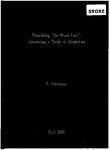Visualising 'The Waste Land': Discovering a Praxis of Adaptation
| dc.contributor.supervisor | Wells, Liz (Professor) | |
| dc.contributor.author | Waterman, Sally | |
| dc.contributor.other | Faculty of Arts, Humanities and Business | en_US |
| dc.date.accessioned | 2011-02-10T17:20:54Z | |
| dc.date.available | 2011-02-10T17:20:54Z | |
| dc.date.issued | 2010 | |
| dc.identifier | 926232 | en_US |
| dc.identifier.uri | http://hdl.handle.net/10026.1/311 | |
| dc.description.abstract |
This research examines the issues and visual processes that arise in the production of self-representations derived from literary texts. The construction of a series of photographic and video installations drawing upon T. S Eliot’s poem 'The Waste Land' (1922) allowed for the exploration and analysis of how literature functions as a device to represent autobiographical experience within my media arts practice. The study considered the relevance and usage of the literary source in relation to specific adaptation procedures, in terms of what complexities were encountered and how these were understood. Whilst orthodox film adaptation provided a theoretical framework for initial experimentation, it is argued that my practice is positioned outside this domain, employing alternative methods of visual translation within a fine art context. Having investigated the purpose of my literary interpretations, I conclude that I respond subjectively to the source materials, forming autobiographical associations with particular lines, images, characters, themes or concepts within the text. It was discovered that this fragmentary method of extraction into isolated elements, corresponded with ambiguous visual representation of the self. Placed within the critical context of relevant female practitioners, I was able to detect a number of recurrent, elusive strategies within my own practice that signified a shifting subjectivity. However, it was the identification with Eliot’s subversion of his impersonality theory in later life, which enabled the realisation that literature is used in my work as a means of projection for visualising past trauma and operates as a form of displacement for a confessional practice. The thesis that emerges from my research is that by allowing oneself to respond emotionally and selectively to an existing text through transformative processes of re-enactment, literary adaptation can act as catharsis for the recollection and re-imagining of previously repressed memories. | en_US |
| dc.language.iso | en | en_US |
| dc.publisher | University of Plymouth | en_US |
| dc.subject | Adaptation | en_US |
| dc.subject | Self-portraiture | en_US |
| dc.subject | Autobiography | en_US |
| dc.subject | Video | en_US |
| dc.subject | Photography | en_US |
| dc.subject | Literature | en_US |
| dc.subject | T.S Eliot | en_US |
| dc.subject | 'The Waste Land' | en_US |
| dc.subject | Film adaptation | en_US |
| dc.subject | Modernism | en_US |
| dc.subject | Gender | en_US |
| dc.subject | Practice-based doctoral reseach | en_US |
| dc.subject | Practice-based PhD | en_US |
| dc.subject | Subjectivity | en_US |
| dc.subject | Memory | en_US |
| dc.subject | Family trauma | en_US |
| dc.subject | Re-enactment | en_US |
| dc.subject | Phototherapy | en_US |
| dc.subject | Literary adaptation | en_US |
| dc.title | Visualising 'The Waste Land': Discovering a Praxis of Adaptation | en_US |
| dc.type | Thesis | |
| dc.identifier.doi | http://dx.doi.org/10.24382/3405 |
Files in this item
This item appears in the following Collection(s)
-
01 Research Theses Main Collection
Research Theses Main


